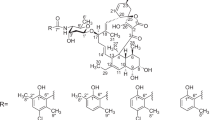Abstract
An anti-mannheimiosis agent, aldsulfin, was isolated from a culture broth of the fungus Lasiodiplodia pseudotheobromae FKI-4499, together with a known compound, lasiodipline C, using bioassay-guided fractionation. Spectroscopic analysis of aldsulfin, using NMR, mass spectrometry, and CD analyses revealed it to be an epithiodiketopiperazine with an unstable and unusual hemithioaminal moiety. Aldsulfin showed antibacterial activity against Mannheimia haemolytica and Pasteurella multocida.




Similar content being viewed by others
References
Johnson K, Burn CC, Wathes DC. Rates and risk factors for contagious disease and mortality in young dairy heifers. CAB Rev. 2011;6:1–10.
Ayalew S, et al. Proteomic and bioinformatic analyses of putative Mannheimia haemolytica secretome by liquid chromatography and tandem mass spectrometry. Vet Microbiol. 2017;203:73–80.
Wilson BA, Ho M. Pasteurella multocida: from zoonosis to cellular microbiology. Clin Microbiol Rev. 2013;26:631–55.
Cusack P, Mcmeniman N, Lean TJ. The medicine and epidemiology of bovine respiratory disease in feedlots. Aust Vet J. 2003;81:480–7.
Ose EE. In vitro antibacterial properties of EL-870, a new semi-synthetic macrolide antibiotic. J Antibiot. 1987;40:190–4.
Andersen NM, Poehlsgaard J, Warrass R, Douthwaite S. Inhibition of protein synthesis on the ribosome by tildipirosin compared with other veterinary macrolides. Antimicrob Agents Chemother. 2012;56:6033–6.
Villarino N, Brown SA, Martin JT. The role of the macrolide tulathromycin in veterinary medicine. Vet J. 2013;198:352–7.
Woolums AR, et al. Multidrug resistant Mannheimia haemolytica isolated from high-risk beef stocker cattle after antimicrobial metaphylaxis and treatment for bovine respiratory disease. Vet Microbiol. 2018;221:143–52.
Wei W, et al. An antibacterial metabolite from Lasiodiplodia pseudotheobromae F2. Phytochemistry. 2014;100:103–9.
Kornerup A, Wanscher JH. Methuen handbook of colour, 3rd ed. London: Eyre Methuen; 1978.
Nonaka K, et al. Staphylotrichum boninense, a new hyphomycete (Chaetomiaceae) from soils in the Bonin Islands, Japan. Mycoscience. 2012;53:312–18.
Iwatsuki M, et al. Lariatins, antimycobacterial peptides produced by Rhodococcus sp. K01-B0171, have a lasso structure. J Am Chem Soc. 2006;128:7486–9.
Eloff JN. A sensitive and quick microplate method to determine the minimal inhibitory concentration of plant extracts for bacteria. Planta Med. 1998;64:711–3.
Altschul SF, et al. Gapped BLAST and PSI-BLAST: a new generation of protein database search programs. Nucl Acids Res. 1997;25:3389–402.
Alves A, Crous PW, Correia A, Phillips AJL. Morphological and molecular data reveal cryptic speciation in Lasiodiplodia theobromae. Fungal Div. 2008;28:1–13.
Wang M, et al. Study on absolute configurations of α/α’ chiral carbons of thiodiketopiperazines by experimental and calculated circular dichroism spectra. Tetrahedron. 2013;69:1195–201.
Lii X, et al. Palmarumycins from endophytic fungus Lasiodiplodia pseudotheobromae XSZ-3. Helv Chim Acta. 2014;97:1289–94.
Kumar S, et al. Xanthine oxidase inhibitors from an endophytic fungus Lasiodiplodia pseudotheobromae. Bioorg Chem. 2019;87:851–6.
Youssef DTA, Alahdal AM. Cytotoxic and antimicrobial compounds from the marine-derived fungus, Penicillium species. Molecules. 2018;23:1–8.
Ma M, et al. In vitro and in vivo pharmacokinetic and pharmacodynamic study of MBRI-001, adeuterium-substituted plinabulin derivative as a potent anti-cancer agent. Bioorg Med Chem. 2018;26:4687–92.
Wen H, et al. Three new indole diketopiperazine alkaloids from Aspergillus ochraceus. Chem Biodivers. 2018;15:1–9.
Soledade M, Pedras C, Abrams SR. Phomalirazine, a novel toxin from the phytopathogenic fungus Phoma lingam. J Am Chem Soc. 1989;111:1904–5.
Kawahara N, Nozawa K, Nakajima S, Kawai K. Studies on fungal products, Part 13. Isolation and structures of dithiosilvatin and silvathione, novel dioxopiperazine derivatives from Aspergillus silvaticus. J Chem Soc Perkin Trans. 1987;1:2099–101.
Zheng CJ, et al. Bionectins A-C, epidithiodioxopiperazines with anti-MRSA activity, from Bionectra byssicola F120. J Nat Prod. 2006;69:1816–9.
Scharf DH, Habel A, Heinekamp T, Brakhage AA, Hertweck C. Opposed effects of enzymatic gliotoxin N- and S-methylations. J Am Chem Soc. 2014;136:11674–9.
Simplicio AL, Clancy JM, Gilmer JF. Prodrugs for amines. Molecules. 2008;13:519–47.
Acknowledgements
We are grateful to Dr. Kenichiro Nagai and Noriko Sato, School of Pharmacy, Kitasato University for measurements of mass and NMR spectra. Dr. Aoi Kimishima for giving me the knowledge of organic chemistry. We sincerely thank Dr. Yoshihiro Shimizu, Dr. Osamu Yoshida, and Dr. Robert L. Harris, Animal Health Division, Eli Lilly Inc. (separated as Elanco Animal Health Inc.) for valuable help on this screening program. This study was partially supported by the Platform Project for Supporting Drug Discovery and Life Science Research (Basis for Supporting Innovative Drug Discovery and Life Science Research (BINDS)) from the Japan Agency for Medical Research and Development (AMED) under Grant Numbers JP19am0101096.
Author information
Authors and Affiliations
Corresponding author
Ethics declarations
Conflict of interest
The authors declare that they have no conflict of interest.
Additional information
Publisher’s note Springer Nature remains neutral with regard to jurisdictional claims in published maps and institutional affiliations.
Supplementary information
Rights and permissions
About this article
Cite this article
Sakai, K., Iwatsuki, M., Iizuka, M. et al. Aldsulfin, a novel unusual anti-mannheimiosis epithiodiketopiperazine antibiotic produced by Lasiodiplodia pseudotheobromae FKI-4499. J Antibiot 74, 363–369 (2021). https://doi.org/10.1038/s41429-021-00411-8
Received:
Revised:
Accepted:
Published:
Issue Date:
DOI: https://doi.org/10.1038/s41429-021-00411-8
- Springer Japan KK
This article is cited by
-
A novel aromatic compound from the fungus Synnemellisia sp. FKR-0921
The Journal of Antibiotics (2023)
-
Minor species of foliar fungal endophyte communities: do they matter?
Mycological Progress (2021)




